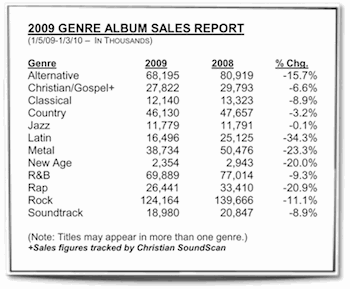
“Record labels shouldn’t worry about falling album sales because digital track sales are making up the difference.”
The above statement, often heard in anecdotal discussions, is easy to prove wrong. Let’s look at 2009’s results for the overall industry. According to Nielsen SoundScan, digital track sales grew by 8.3% from 1.07 billion to 1.159 billion, an increase of 89 million. Album sales (including digital albums) slid 12.7% from 428.4 million to 373.9 million, or down 54.4 million units.
Now some basic math: Our formula includes revenue (to record labels) of .70¢ per digital track and average revenue of $9.25 per album sale.
Results: 2009 digital track revenue grew about $62.3 million while album sales revenue fell about $503 million showing a 2009 net revenue loss in excess of $440 million.
So clearly digital track sales are not fully replacing lost album sales revenue. In fact during 2009, digital track increases offset less than 15% of the revenue lost from shrinking album purchases.
 Another byproduct from album sales tumbling about 50% over the last decade (2000: 785.1 million units; 2009: 373.9 million) is that artists already on the Top Ten Selling Album Artists of the SoundScan Era (1991-1/3/2010) are increasingly likely to become “grandfathered.”
Another byproduct from album sales tumbling about 50% over the last decade (2000: 785.1 million units; 2009: 373.9 million) is that artists already on the Top Ten Selling Album Artists of the SoundScan Era (1991-1/3/2010) are increasingly likely to become “grandfathered.”
There are four Nashville artists on this exalted Top Ten list: Garth Brooks (No. 1; 68.363 million units sold), George Strait (No. 6; 41.843 million), Tim McGraw (No. 7; 38.677) and Alan Jackson (No. 8; 37.447). This group is likely to become the faces on the Mount Rushmore of all-time country album sales.
For example, Taylor Swift’s Fearless was the top selling album in 2009 and scanned about 3.217 million units. Across all her titles she reached about 4.6 million. Carrie Underwood was the second highest selling Nashville artist with a total of 1.895 million units. Trying to reach 40 million career album units in the face of diminishing album sales is becoming increasingly difficult. It will be extremely rare to see any new artists enter those rankings.
Our final math exhibit is sure to please calendar scribes. This year’s SoundScan numbers are based upon a 52 and 53 week period. Last year’s rankings ended on 12/29/08 and this year the closing date was 1/3/10, a 53 week period. However, SoundScan has chosen to view some data based on the full 53 weeks and some on a 52 week span, starting 1/5/09. This “apples to oranges” approach is confusing everyone. Basically note that for year-to-year sales comparisons the data researchers have used the 52-week period, but for individual artist rankings they are covering the full 53 weeks. This means that officially country sales (based upon 52 weeks, see chart page 1) were down 3.2% and overall industry album sales were down 12.7%. Note that except for the Jazz format, country had the smallest sales drop this year.

Category: Featured, Sales/Marketing
About the Author
David M. Ross has been covering Nashville's music industry for over 25 years. dross@musicrow.comView Author Profile


